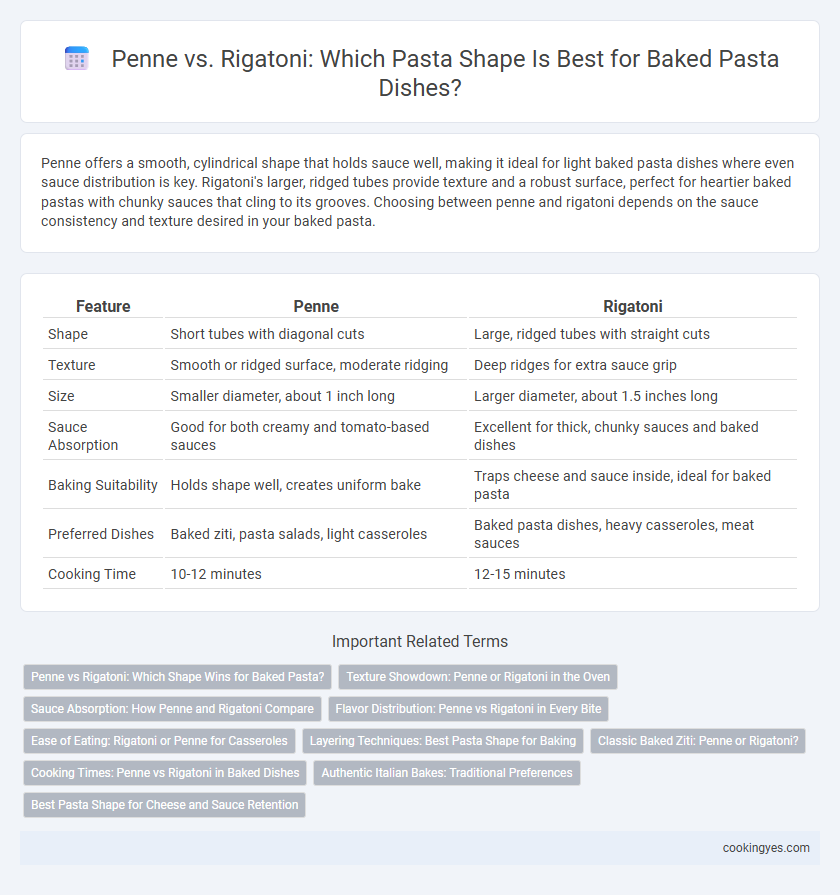Penne offers a smooth, cylindrical shape that holds sauce well, making it ideal for light baked pasta dishes where even sauce distribution is key. Rigatoni's larger, ridged tubes provide texture and a robust surface, perfect for heartier baked pastas with chunky sauces that cling to its grooves. Choosing between penne and rigatoni depends on the sauce consistency and texture desired in your baked pasta.
Table of Comparison
| Feature | Penne | Rigatoni |
|---|---|---|
| Shape | Short tubes with diagonal cuts | Large, ridged tubes with straight cuts |
| Texture | Smooth or ridged surface, moderate ridging | Deep ridges for extra sauce grip |
| Size | Smaller diameter, about 1 inch long | Larger diameter, about 1.5 inches long |
| Sauce Absorption | Good for both creamy and tomato-based sauces | Excellent for thick, chunky sauces and baked dishes |
| Baking Suitability | Holds shape well, creates uniform bake | Traps cheese and sauce inside, ideal for baked pasta |
| Preferred Dishes | Baked ziti, pasta salads, light casseroles | Baked pasta dishes, heavy casseroles, meat sauces |
| Cooking Time | 10-12 minutes | 12-15 minutes |
Penne vs Rigatoni: Which Shape Wins for Baked Pasta?
Penne's slimmer, tubular shape with angled ends allows for a more even sauce distribution and crispier edges when baked, enhancing texture and flavor absorption. Rigatoni's larger, ridged tubes hold thicker sauces and cheese superbly, delivering a heartier bite ideal for dense baked dishes. Choosing between Penne and Rigatoni depends on whether a lighter, crispier bake or a robust, sauce-rich experience is preferred for your pasta dish.
Texture Showdown: Penne or Rigatoni in the Oven
Penne and rigatoni each offer distinct textures when baked, with penne providing a firm bite and smooth exterior that crisps slightly at the edges. Rigatoni's larger size and ridged surface trap more sauce and cheese, creating a tender yet robust texture that holds up well under heat. The choice depends on whether a denser, chewier bite (rigatoni) or a slightly crisp, delicate finish (penne) suits the baked pasta dish best.
Sauce Absorption: How Penne and Rigatoni Compare
Penne's narrow, tubular shape allows it to hold sauce both inside and on its ridged exterior, enhancing flavor absorption during baking. Rigatoni, larger with deep ridges and a wider diameter, traps more chunky sauces and cheese, providing a heartier texture in baked dishes. Both pasta types excel at absorbing sauce, but rigatoni is ideal for thicker, creamier sauces while penne works best with lighter tomato or oil-based sauces.
Flavor Distribution: Penne vs Rigatoni in Every Bite
Penne's narrow, cylindrical shape with angled edges allows sauces to cling smoothly, enhancing flavor in each bite, while rigatoni's larger, ridged tubes trap chunky ingredients and baked cheese effectively, offering a robust taste experience. The ridges on rigatoni amplify sauce adhesion, making it ideal for heavier, meat-based sauces, whereas penne provides a balanced sauce-to-pasta ratio suited for lighter tomato or cream sauces. Both shapes excel in baked dishes, but rigatoni delivers a heartier, texture-rich flavor distribution compared to penne's consistent, subtle coating.
Ease of Eating: Rigatoni or Penne for Casseroles
Rigatoni's larger diameter and ridged surface hold sauce and cheese effectively, creating a satisfying texture in baked casseroles but may be slightly more challenging to eat due to its size. Penne, with its smaller, smooth tubes, offers easier bite-sized portions and smoother chewing, making it more manageable for quick consumption while still absorbing flavors. Choosing between rigatoni and penne for baked pasta casseroles depends on whether ease of eating or sauce retention is prioritized.
Layering Techniques: Best Pasta Shape for Baking
Penne's smooth surface and hollow tube structure allow sauces to penetrate deeply, making it ideal for layered baked pasta recipes that require even sauce distribution. Rigatoni's ridged exterior and larger diameter hold thicker sauces and cheese more effectively, enhancing texture and flavor in baked dishes with multiple ingredient layers. Choosing between penne and rigatoni depends on the desired layering density and sauce absorption for a perfectly balanced baked pasta.
Classic Baked Ziti: Penne or Rigatoni?
For classic baked ziti, rigatoni's ridged surface and larger diameter hold sauce and cheese more effectively than penne, enhancing every bite with rich flavor. Penne, with its smoother texture and smaller size, offers a lighter pasta experience but may not trap as much sauce in baked dishes. Choosing rigatoni maximizes the hearty, saucy appeal typical of traditional baked ziti recipes.
Cooking Times: Penne vs Rigatoni in Baked Dishes
Penne typically requires 11 to 13 minutes of boiling before baking, while rigatoni needs slightly longer, around 12 to 14 minutes, due to its thicker walls and larger diameter. The difference in cooking times affects texture; penne achieves a tender bite more quickly, whereas rigatoni retains firmness and holds sauces better during baking. Adjusting pre-bake boiling time ensures both pastas reach optimal doneness without becoming mushy in baked dishes like casseroles or pasta al forno.
Authentic Italian Bakes: Traditional Preferences
Traditional Italian baked dishes often favor rigatoni due to its large, ridged tubes that capture thick sauces and melted cheese, enhancing flavor and texture. Penne, with its smaller, diagonally-cut shape, offers a slightly lighter bite but is less common in hearty baked recipes like pasta al forno. Authentic Italian kitchens prioritize pasta shapes like rigatoni that maintain structure and absorb robust ragu or bechamel layers during baking.
Best Pasta Shape for Cheese and Sauce Retention
Penne's tubular shape with diagonal cuts allows cheese and sauce to cling inside, creating a rich, flavorful bite every time. Rigatoni's larger tubes and ridged surface excel at holding chunky sauces and melted cheese, making it ideal for baked pasta dishes with hearty toppings. Both shapes enhance sauce retention, but penne offers a more balanced cheese-to-pasta ratio while rigatoni maximizes sauce capture for indulgent casseroles.
Penne vs Rigatoni for baked pasta Infographic

 cookingyes.com
cookingyes.com